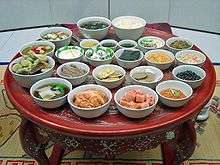Yakgwa
.jpg) | |
| Type | Hangwa |
|---|---|
| Place of origin | Korea |
| Main ingredients | Wheat flour, honey, sesame oil |
|
| |
| Yakgwa | |
| Hangul | 약과 |
|---|---|
| Hanja | 藥菓 |
| Revised Romanization | yakgwa |
| McCune–Reischauer | yakgwa |
 |
| This article is part of a series on |
| Korean cuisine 한국 요리 조선 료리 |
|---|
|
Staples |
|
Condiments |
|
|
Yakgwa is a Korean traditional dish. It was originally considered as a dessert and more recently as a confectionery (hangwa), because of its sweet taste and flower biscuit shape. Yakgwa is made mainly from honey, sesame oil, and wheat flour.[1][2][3]
Origin
The origin of yakgwa is not clear since this food had many different names. However, it seems like Korean people started to eat it during the Unified Shilla era. During the Goryeo Dynasty, yakgwa was known even in China under the name Goryeo mandu. This is from the Joseon Dynasty era that yakgwa was being called yakgwa. It was an essential dessert in the Goryeo royal court.[4]
Literally, yakgwa means the medicinal (藥) confectionery (菓). This name came from the main ingredients it is made of. In Korea, during the Joseon Dynasty era, honey was considered as a medicine good for health. That is why it was called the medicinal confectionery.[5]
Ingredients
Yakgwa is traditionally made of honey, sesame oil, and wheat flour. Recently, Yakgwa has been manufactured by corporations that add more ingredients in order to improve the taste of the biscuit.
Formation
The Yakgwa gets it shape by being pressed into wooden molds or flattened on decorative tiles. Both the pistol and molds must be greased with sesame oil.[6]
See also
- Mandugwa
- List of Korean desserts
-
 Food portal
Food portal
References
- ↑ "약과" (in Korean). Doopedia. Retrieved 2015-05-24.
- ↑ "How to Make Yakgwa, Korean Honey Cookies". About.com. Retrieved 2015-05-24.
- ↑ Timothy G. Roufs, Kathleen Smyth Roufs (2014). Sweet Treats around the World: An Encyclopedia of Food and Culture. ABC-CLIO. p. 213. ISBN 9781610692212.
- ↑ "Traditional Snacks". Korea Tourism Organization. Retrieved 2015-05-24.
- ↑ 재미있는 한국어읽기2급,연세대학교 출판부, 제1과 음식 p. 13
- ↑ Chef Sue Lee, Embessey Chefs "Korea" 2003